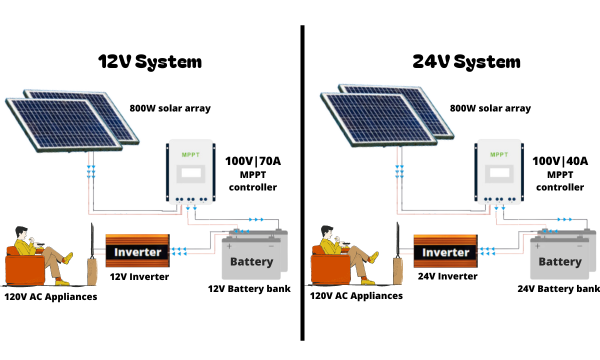What size charge controller for 800W solar panel

The solar charge controller is used to deliver the correct amount of voltage to the batteries as the amount fluctuates due to environmental conditions. It will make sure the batteries are getting the right voltage by monitoring your solar panels and the battery condition at all times.
The size of the solar controller is often in the name of two rating; the maximum charging current rating and the maximum input voltage rating that it can accept from the solar panel array.
Depending on the system's voltage (12V, or 24V) and the wiring method of your solar panels, the size of the solar charge controller you would need for a 800W solar panel array is between 40 and 70 amps.
Rating #1. Maximum charging current
- 12V Battery pack
With a 12V system, 800-watt array on a 12-volt system requires about 66.6A (=800w/12v) of charge current.
Thus, the current rating of the charge controller should be at least 66.6 amps. In the market, generally, the solar controllers out there are either 65 or 70 amps so you would need the controller with the next higher rating. In this case, a 70 amp solar charge controller works well.
- 24V Battery pack
If you want to use a smaller size charge controller, you should have a 24 Volt system (24V inverter and 24V battery pack). This will reduce the charging current (less current, meaning cheaper controller).If we calculate the output current, it will be 800W/24V=33A. Therefore, a 40 amp solar charge controller would works well.
Rating #2. Maximum input voltage-current
It's important to follow the manufacturer's specifications for the charge controller to prevent damage.
Next, we need to choose the charge controller that is compatible with our panel's solar panel array’s output.
Voltage output of your 800W solar panel array
The solar panels input voltage of the controller must be higher the array’s maximum voltage output.
In the market. For the 12V/24V battery bank, most controller's input voltage out there are range between 20V and 150V.
Using a solar array configurations with a voltage lower than the controller's maximum range is safe, but exceeding it can cause permanent damage.
In the cold of winter the Voc voltage of the array can goes higher as temperature drops.
Therefore, temperature compensation is crucial for properly sizing your solar panel array for the charge controller. For example, if the Voc of a single solar panel is 22.7V and you have four connected in series, the total Voc before compensation is 22.7V x 3 = 90.8V.
However, considering the 0°C temperature on the coldest day, you need use the temperature coefficient (1.10) to calculate the temperature-compensated Voc: 90.8V x 1.10 = 99.9V. This adjusted value is safe for a 100V rated charge controller.
Amp output of your 800W solar panel array
The solar panels input current of the controller must be higher than the array’s maximum short circuit current (Isc) output.
This ensure that the controller can handle the current generated by the panels without being overwhelmed.
For example, if the Isc of a single solar panel is 5.5V and you have two strings connected in parallel, the total Isc is 5.5V x 2 = 11A.
Conclusion
You’ll need to get a charge controller whit specification that fits the electric output of your solar panel arrays. If you intend to scale up your solar power generator, you’ll do better with a larger charge controller with room to accommodate more solar panels than with two smaller-sized ones.

